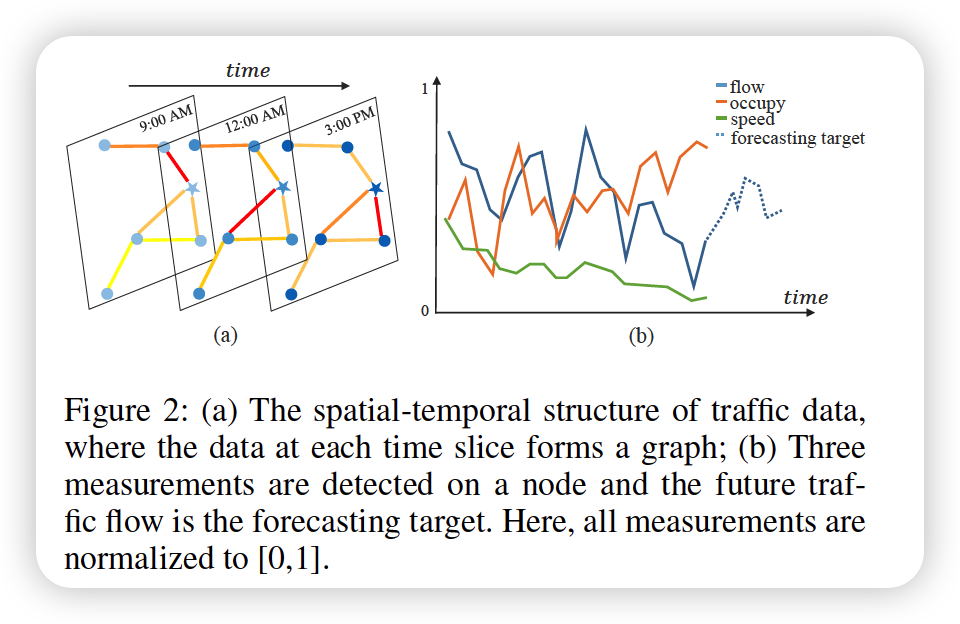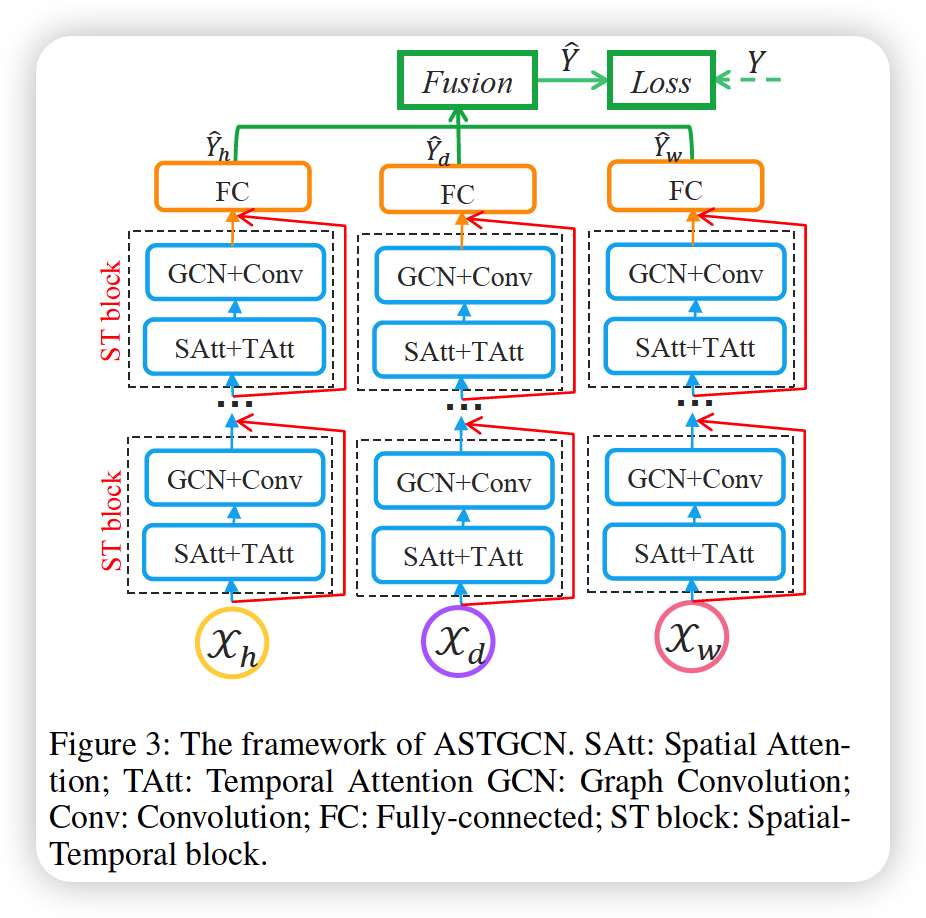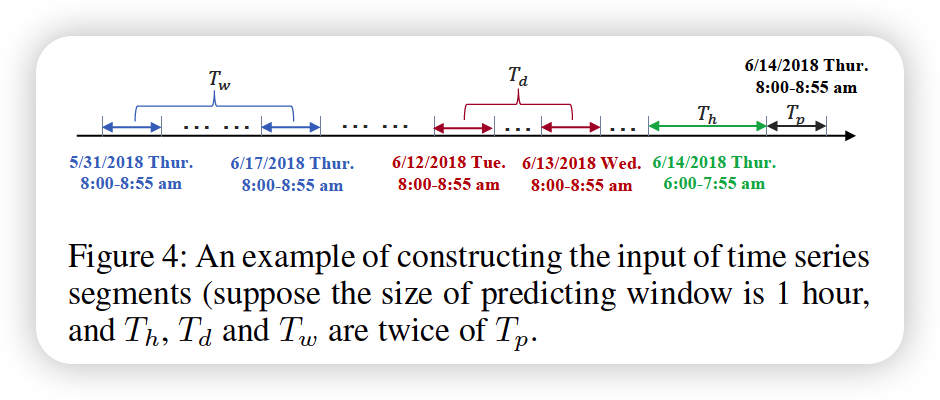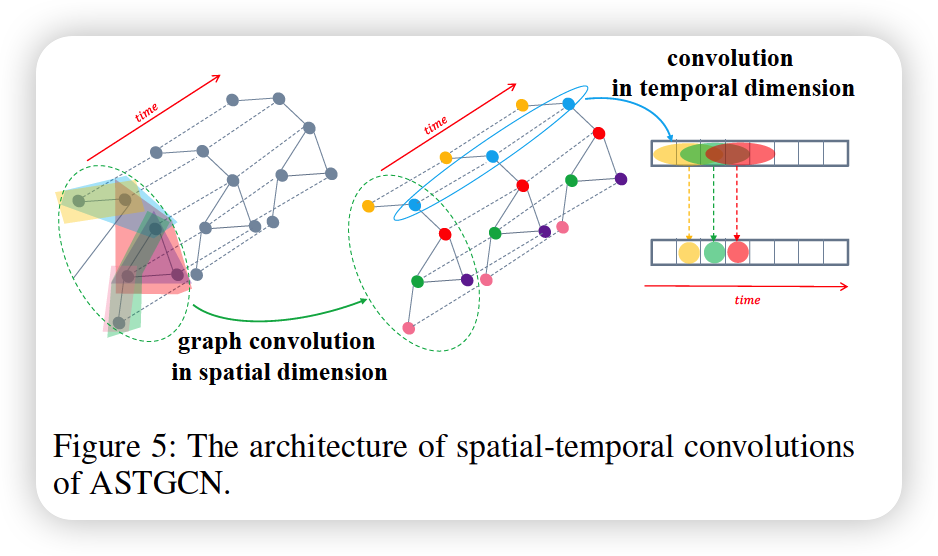ASTGCN : Attention Based Spatial-Temporal GCN for Traffic Flow Forecasting (2019)
Contents
- Abstract
- Preliminaries
- Traffic Networks
- Traffic Flow Forecasting
- AST-GCN
- Spatial Temporal Attention
- Spatial Temporal Convolution
- Multi-component Fusion
0. Abstract
Existing methods
- lacking abilities of modeling the dynamic spatial-temporal correlations of traffic data
ASTGCN
-
Attention based spatial-temporal GCN
-
consists of 3 independent components,
to model 3 temporal properties
- (1) recent
- (2) daily-periodic
- (3) weekly-periodic
-
each component contains 2 major parts
-
(a) spatial-temporal attention
\(\rightarrow\) to capture the dynamic spatial temporal correlation
-
(b-1) spatial-temporal convolution
\(\rightarrow\) to capture the spatial patterns
-
(b-2) common standard convolutions
\(\rightarrow\) to capture the temporal patterns
-
output of 3 components are fused \(\rightarrow\) final result!
1. Preliminaries
(1) Traffic Networks
\(N\) nodes = \(N\) devices
- each device has \(F\) measurements ( = \(F\)-dim feature vector )

(2) Traffic Flow Forecasting
Notation
- \(f\)-th time series on each node ( \(f \in\) \((1, \ldots, F))\)
- \(\mathcal{X}=\left(\mathbf{X}_{1}, \mathbf{X}_{2}, \ldots, \mathbf{X}_{\tau}\right)^{T} \in \mathbb{R}^{N \times F \times \tau}\).
- \(\mathbf{x}_{t}^{i} \in \mathbb{R}^{F}\) : values of ALL features of node \(i\) at time \(t\)
- \(x_{t}^{c, i} \in \mathbb{R}\) : \(c\)-th feature of node \(i\) at time \(t\)
- \(\mathbf{x}_{t}^{i} \in \mathbb{R}^{F}\) : values of ALL features of node \(i\) at time \(t\)
- \(y_{t}^{i}=x_{t}^{f, i} \in \mathbb{R}\) : traffic flow of node \(i\) at time \(t\) in the future
Problem
- given \(\mathcal{X}\), ( window size = \(\tau\) )
- predict \(\mathbf{Y}=\left(\mathbf{y}^{1}, \mathbf{y}^{2}, \ldots, \mathbf{y}^{N}\right)^{T} \in \mathbb{R}^{N \times T_{p}}\)
2. AST-GCN

- 3 independent components
- \(h\) : recent
- \(d\) : daily-periodic
- \(w\) : weekly-periodic
Notation
- sampling frequency : \(q\) times per day
- current time : \(t_0\)
- forecast horizon : \(T_p\)
- \(T_h, T_d, T_w\) : length of 3 TS segments
- all interger multiples of \(T_p\)

RECENT segment
\(\mathcal{X}_{h}=\left(\mathbf{X}_{t_{0}-T_{h}+1}, \mathbf{X}_{t_{0}-T_{h}+2}, \ldots, \mathbf{X}_{t_{0}}\right) \in \mathbb{R}^{N \times F \times T_{h}}\).
DAILY-PERIODIC segment
\(\begin{aligned} &\mathcal{X}_{d}=\left(\mathbf{X}_{t_{0}-\left(T_{d} / T_{p}\right) * q+1}, \ldots, \mathbf{X}_{t_{0}-\left(T_{d} / T_{p}\right) * q+T_{p}},\right. \\ &\mathbf{X}_{t_{0}-\left(T_{d} / T_{p}-1\right) * q+1}, \ldots, \mathbf{X}_{t_{0}-\left(T_{d} / T_{p}-1\right) * q+T_{p}}, \ldots \end{aligned}\).
WEEKLY-PERIODIC segment
\[\mathcal{X}_{w}=\left(\mathbf{X}_{t_{0}-7 *\left(T_{w} / T_{p}\right) * q+1}, \ldots, \mathbf{X}_{t_{0}-7 *\left(T_{w} / T_{p}\right) * q+T_{p}}\right. \text {, }\]\(\begin{aligned} &\mathbf{X}_{t_{0}-7 *\left(T_{w} / T_{p}-1\right) * q+1}, \ldots, \mathbf{X}_{t_{0}-7 *\left(T_{w} / T_{p}-1\right) * q+T_{p}}, \ldots \\ &\left.\mathbf{X}_{t_{0}-7 * q+1}, \ldots, \mathbf{X}_{t_{0}-7 * q+T_{p}}\right) \in \mathbb{R}^{F \times N \times T_{w}} \end{aligned}\).
Summary
- 3 components share same structure
- each structure consists of several spatial-temporal blocks & FC layer
- spatial-temporal blocks
- (1) spatial-temporal attention module
- (2) spatial-temporal convolution module
- adopt a residual learning framework
- output of 3 components are merged!
(1) Spatial Temporal Attention
2 kinds of attention
- (1) spatial attention
- (2) temporal attention
a) spatial attention
ex) recent component
\(\mathbf{S}=\mathbf{V}_{s} \cdot \sigma\left(\left(\mathcal{X}_{h}^{(r-1)} \mathbf{W}_{1}\right) \mathbf{W}_{2}\left(\mathbf{W}_{3} \mathcal{X}_{h}^{(r-1)}\right)^{T}+\mathbf{b}_{s}\right)\),
-
\(\mathbf{S}_{i, j}^{\prime}=\frac{\exp \left(\mathbf{S}_{\mathrm{i}, \mathrm{j}}\right)}{\sum_{j=1}^{N} \exp \left(\mathbf{S}_{\mathrm{i}, \mathrm{j}}\right)}\),
-
\(\mathcal{X}_{h}^{(r-1)}=\left(\mathbf{X}_{1}, \mathbf{X}_{2}, \ldots \mathbf{X}_{T_{r-1}}\right) \in \mathbb{R}^{N \times C_{r-1} \times T_{r-1}}\),
- input of the \(r^{t h}\) spatial-temporal block
-
when \(r=1, C_{0}=F\)
- \(T_{r-1}\) : length of temporal dimension in \(r^{th}\) layer
attention matrix \(\mathbf{S}\) is dynamically computed
( according to the current input )
- \(\mathbf{S}_{i,j}\) : correlation strength between node \(i\) & \(j\)
when performing GCN, use 2 matrix
- (1) adjacency matrix : \(\mathbf{A}\)
- (2) spatial attention matrix : \(\mathbf{S}^{\prime} \in \mathbb{R}^{N \times N}\)
b) temporal attention
\(\mathbf{E}=\mathbf{V}_{e} \cdot \sigma\left(\left(\left(\boldsymbol{\mathcal { X }}_{h}^{(r-1)}\right)^{T} \mathbf{U}_{1}\right) \mathbf{U}_{2}\left(\mathbf{U}_{3} \mathcal{X}_{h}^{(r-1)}\right)+\mathbf{b}_{e}\right)\).
- \(\mathbf{E}_{i, j}^{\prime}=\frac{\exp \left(\mathbf{E}_{\mathrm{i}, \mathrm{j}}\right)}{\sum_{j=1}^{T_{r-1}} \exp \left(\mathbf{E}_{\mathrm{i}, \mathrm{j}}\right)}\).
- temporal correlation matrix \(\mathbf{E}\) is determined by the varying inputs
- correlation strength between time \(i\) & \(j\)
Adjusted Input
\[\hat{\mathcal{X}}_{h}^{(r-1)}=\left(\hat{\mathbf{X}}_{1}, \hat{\mathbf{X}}_{2}, \ldots, \hat{\mathbf{X}}_{T_{r-1}}\right)=\left(\mathbf{X}_{1}, \mathbf{X}_{2}, \ldots, \mathbf{X}_{T_{r-1}}\right) \mathbf{E}^{\prime} \in \mathbb{R}^{N \times C_{r-1} \times T_{r-1}}\](2) spatial-temporal convolution

a) Graph convolution in spatial dimension
\(g_{\theta} *_{G} x=g_{\theta}(\mathbf{L}) x=\sum_{k=0}^{K-1} \theta_{k} T_{k}(\tilde{\mathbf{L}}) x\).
- \(\theta \in \mathbb{R}^{K}\).
- \(\tilde{\mathbf{L}}=\frac{2}{\lambda_{\max }} \mathbf{L}-\mathbf{I}_{N}\).
- \(T_{k}(x)=2 x T_{k-1}(x)-T_{k-2}(x)\).
In order to dynamically adjust the correlations between nodes,
for each term of Chebyshev polynomial, use \(T_{k}(\widetilde{\mathbf{L}})\) with \(\mathbf{S}^{\prime} \in \mathbb{R}^{N \times N}\)
\(\rightarrow\) \(g_{\theta} *_{G} x=g_{\theta}(\mathbf{L}) x=\sum_{k=0}^{K-1} \theta_{k}\left(T_{k}(\tilde{\mathbf{L}}) \odot \mathbf{S}^{\prime}\right) x\)
Generalize this! can see it as mutiple channels
-
input : \(\hat{\mathcal{X}}_{h}^{(r-1)}=\left(\hat{\mathbf{X}}_{1}, \hat{\mathbf{X}}_{2}, \ldots, \hat{\mathbf{X}}_{T_{r-1}}\right) \in \mathbb{R}^{N \times C_{r-1} \times T_{r-1}}\)
-
feature of node have \(C_{r-1}\) channels
-
for each time step \(t\), perform \(C_{r}\) filters on the graph \(\hat{\mathbf{X}}_{t}\)
( kernel : \(\Theta=\left(\Theta_{1}, \Theta_{2}, \ldots, \Theta_{C_{r}}\right) \in \mathbb{R}^{K \times C_{r-1} \times C_{r}}\) )
\(\rightarrow\) get \(g_{\theta} *_{G} \hat{\mathbf{X}}_{t}\)
-
b) Convolution in temporal dimension
\(\mathcal{X}_{h}^{(r)}=\operatorname{ReLU}\left(\Phi *\left(\operatorname{ReLU}\left(g_{\theta} *_{G} \hat{\mathcal{X}}_{h}^{(r-1)}\right)\right)\right) \in \mathbb{R}^{C_{r} \times N \times T_{r}}\).
(3) Multi-Component Fusion
\(\hat{\mathbf{Y}}=\mathbf{W}_{h} \odot \hat{\mathbf{Y}}_{h}+\mathbf{W}_{d} \odot \hat{\mathbf{Y}}_{d}+\mathbf{W}_{w} \odot \hat{\mathbf{Y}}_{w}\).
